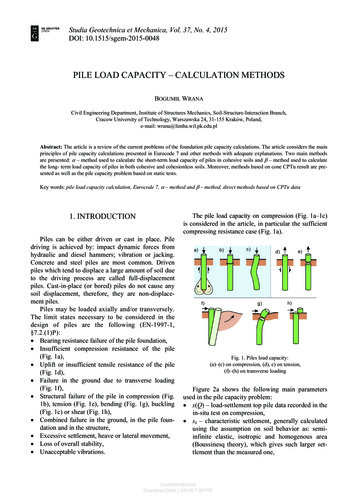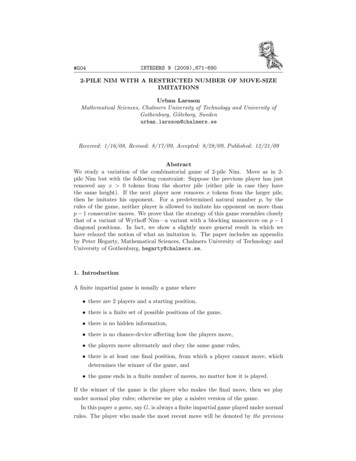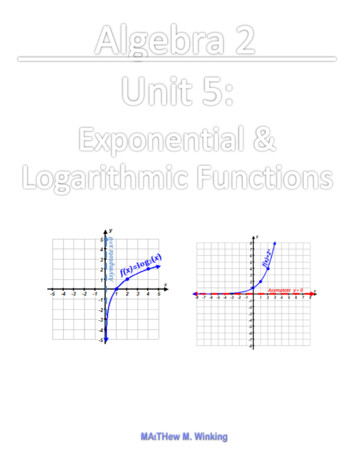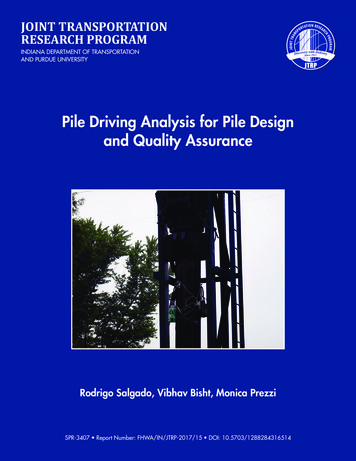
Transcription
CHAPTER 5OCTOBER 2015CHAPTER5Pile Foundations - General5-1 IntroductionPile foundations are used when the underlying soils are incapable of resisting the loadsfrom the structure. The piling is placed in the ground through poor quality materials tobear on competent soils. The piles are either driven into the ground or holes are drilledand filled with reinforced concrete. The piles transfer the load by bearing on competentmaterial or through the friction between the soil and the pile (skin friction.)Pile foundations can be categorized into two general types: displacement piles andreplacement piles. A displacement pile is a pile that is driven or vibrated into the groundand displaces the surrounding soil during installation. A replacement pile is a pile that isplaced or constructed within a previously drilled borehole and replaces the excavatedsoil. Chapter 7, Driven Piles, contains information on displacement piles. Chapters 6,Cast-In-Drilled-Hole Piles; Chapter 9, Slurry Displacement Piles; and Chapter10, PierColumns, contain information on replacement, or cast-in-place piles. Chapter 13,Micropiles, contains information on alternative piles and micropiles, which can be acombination of displacement and replacement piles.Driven piles are braced structural columns that are driven, pushed, or otherwise forcedinto the soil. Two types of pile foundations were developed through the ages to supportstructures on poor quality soil: piles and piers. Piles are more commonly used and areessentially small diameter piers that work in groups. Pier foundations are large indiameter and tend to work independently. They have gained favor over the last severalyears as they behave very well seismically. Piles/Piers can be classified as friction piles,end bearing piles, or a combination of the two. They can also provide lateral stability infoundations. Friction piles can transfer both tensile and compressive forces to thesurrounding soil.5-2 SpecificationsThe specifications for piling are contained in the Standard Specifications 1. Projectspecific requirements and revisions to the Standard Specifications are included in the12010 SS Section 49, Piling.CALTRANS FOUNDATION MANUAL5-1
CHAPTER 5OCTOBER 2015Special Provisions. The contract plans and Standard Plans are additional contractdocuments needed for pile work and describe what piling goes where for each structure.In general, the contract plans describe the intended pile type, specified tip elevation(s)and a minimum nominal resistance. The contract specifications provide project-specificrequirements on how to perform the work. These documents also include specificrequirements for activities such as embankment pre-drilling, load testing, and other itemsspecific to a project. For example, if difficult driving is anticipated, the Designer mayprovide the option of using either steel “H” piling or precast concrete piles. When thisoption is written into the contract, the Contractor is allowed to choose the mosteconomical option. If specifications allowing options are not included in the contract,then changes from one pile type to another cannot be made without a contract changeorder and concurrence from the Designer.Details for the different classes of typical piles are found in the Standard Plans whiledetails for atypical or nonstandard piles are shown on the contract plans. The StandardPlans also provide options and alternative details for the different classes of piles. Notethat different pile classes are not interchangeable. For example, when Class 140 piles arespecified, the Contractor can select either of the alternatives shown in the Standard Plansfor Class 140 piles but cannot select an option from a different class of piles such asClass 90 or 200. Occasionally, the Designer may decide to exclude some of thealternatives for a given class of pile. In this situation, the excluded alternatives will benoted in the special provisions or contract plans.The Standard Specifications contain the general information for pile work. This includesspecifics for submittals, type of materials, quality assurance, construction procedures,measurement, and payment. Remember that the Special Provisions and the contract planshave precedence over the Standard Plans and Standard Specifications. For this reason, itis imperative that all contract documents be thoroughly reviewed well in advance of thework and inconsistencies resolved prior to start of work.5-3 Cast-in-Place PilesThe 2010 version of the Standard Specifications identifies 3 different types of cast-inplace (CIP) piles. They are as follows:1. Cast-in-Drilled-Hole (CIDH) concrete piles.2. CIDH concrete pile rock sockets.3. Driven steel shells filled with concrete and reinforcement.The first type is typically known as a Cast-in-Drilled-Hole (CIDH) Pile. The second typeis essentially a CIDH pile drilled in rock. Sometimes combinations of two or more typesof cast-in-place piles are used to construct a single pile. This can happen when softmaterials such as clays overlay rock formations. Permanent or temporary steel casingsmay be utilized for the first two types. The third type involves the installation of a steelCALTRANS FOUNDATION MANUAL5-2
CHAPTER 5OCTOBER 2015shell, removal of the soil inside the steel shell and subsequently filling with reinforcedconcrete. Steel shells add to structural capacity to the pile while steel casings generallyhave no structural value and are only used to facilitate construction.The 2006 version of the Standard Specifications identifies four (4) different types of castin-place piles. They are as follows:1. Steel shells driven permanently to the required nominal resistance and penetrationand filled with concrete.2. Steel casings installed permanently to the required penetration and filled withconcrete.3. Drilled holes filled with concrete.4. Rock sockets filled with concrete.The first two types involve the installation of a permanent steel casing or shell, removalof the soil inside the casing and subsequently filling with reinforced concrete. Steel shellsadd to structural capacity to the pile while casings are assumed to have no structuralvalue and are only used to facilitate construction. The third type is typically known as aCIDH Pile. The last type is essentially a CIDH pile drilled in rock. Sometimescombinations of two or more types of cast-in-place piles are used to construct a singlepile. This can happen when soft materials such as clays overlay rock formations.Permanent or temporary steel casings may be utilized for these two types.Cast-In-Drilled-Hole piles are made of reinforced concrete cast into holes drilled in theground to a specified tip elevation. Diameters generally range from 12 to 168 inches andlengths range from 10 feet to well over 200 feet. They are satisfactory in suitable materialand are generally more economical than most other types of piling. They are especiallyadvantageous where vibration from pile driving operations might damage adjacentinfrastructure, such as pipelines or buildings. The geological ground formations intowhich the holes are drilled must be capable of retaining their shape during drilling andconcrete placement operations and no groundwater should be present.If there are concerns about the presence of groundwater, the slurry displacement methodspecifications may need to be utilized. Cast-In-Drilled-Hole piles are discussed in moredetail in Chapters 6, Cast-In-Drilled-Hole Piles, and Chapter 9, Slurry DisplacementPiles. Special consideration piles, such as those for changeable message signs (CMS), arediscussed in Chapter 13, Micropiles.5-4 Driven PilesDriven piles typically consist of three different types: (1) concrete, (2) steel, and (3)timber. A general description of each type is given below. Driven piles are discussed inmore detail in Chapter 7, Driven Piles.CALTRANS FOUNDATION MANUAL5-3
CHAPTER 5OCTOBER 2015Table 5-1. Driven Pile TypesTYPE OFPILEDriven Piles –ConcreteDESCRIPTIONDriven concrete piles come in a variety of sizes, shapes, and methods of construction.In cross section, they can be square, octagonal, round, solid or hollow. These pilesgenerally vary in sizes from 10 to 60 inches in diameter and consist of precastprestressed concrete.Caltrans has standard details for splicing precast concrete piles but it is a difficult,time consuming, and expensive procedure. Hence, this almost precludes the use ofprecast piles where excessively long piles are required to obtain necessary bearing.Driven Piles –SteelThe unit cost to furnish concrete piles is usually lower than the steel equivalent. Butthis cost is often offset by the requirement for a larger crane and hammer to handlethe heavier pile. This is particularly true when there are a small number of piles todrive.Steel piling includes structural shape piles and pipe piles. Structural shape piles aregenerally used for lower capacity piles shown in the Standard Plans. Pipe piles aregenerally used for high capacity piles. The pipe section is a standard alternate forstructural shape Class 90 and 140 piling, but is seldom used.Although steel piling is relatively expensive on a “per foot” furnish basis, it has anumber of advantages. Structural shape steel piles come in sizes varying from HP 8 x36 to HP 14 x 117 rolled shapes or may consist of structural steel plates weldedtogether. They are available in high strength and corrosion-resistant steels. They canpenetrate to bedrock where other piles would be destroyed by driving. However, evenwith “H” piles, care must be taken when long duration hard driving is encountered asthe pile tips can be damaged or the intended penetration path of the pile can bedrastically deflected. Using a reinforced point on the pile can sometimes prevent thistype of damage. Due to the light weight and relative ease of splicing, they are usefulwhere great depths of unstable material must be penetrated before reaching thedesired load carrying stratum and in locations where reduced clearances require useof short sections. They are useful where piles must be closely spaced to carry a heavyload because they displace a minimal amount of material when driven.Steel pipe piling comes in sizes varying from 10 to 120 inches in diameter, for heavywalled pipe that are driven directly with the hammer to thin walled or step-taperpipes which are driven with a mandrel. The steel shell may have a flat bottom or bepointed, and may be step-tapered or a uniform section. Steel pipe piling may or maynot be filled with reinforced concrete.Splice details are shown on the Standard Plans and contract plans for contracts thatpermit the use of steel piling. Pile welding work requires the submittal andauthorization of a Welding Quality Control Plan. The requirements for the WeldingQuality Control Plan are addressed in the contract specifications 2.Sometimes “H” piles must be driven below the specified tip elevation before thenominal driving resistance is attained. This can present an administrative problem(cost) if the length driven below the specified tip elevation is significant. Steel lugs22010 SS, Section 11-3.02, Welding Quality Control, or Special Provisions for contracts using 2006 SS.CALTRANS FOUNDATION MANUAL5-4
CHAPTER 5TYPE OFPILEDriven Piles –WoodOCTOBER 2015DESCRIPTIONwelded to the piles are commonly used to solve this problem. This subject is coveredin detail in Bridge Construction Memo 130-5.0, Steel H-Pile Lugs.Untreated timber piles may be used for temporary construction, revetments, fendersand similar work; and in permanent construction where allowed by the contractspecifications. They are also sometimes used for trestle construction, although treatedpiles are preferred. Timber piles are difficult to extend, hard to anchor into thefooting to resist uplift, and subject to damage if not driven carefully. Timber pilesalso have a maximum allowable bearing capacity of 90 kips, whereas most structurepiles are designed for at least 140 kips.5-5 Micropiles and Alternative PilesMicropiles are currently used when the contract specifications allow their use. The Statestandard micropile design or proprietary micropile systems may be used. At the time ofpublication, the Alternative Piling specifications were being rewritten, and there are nocurrently approved alternative piling systems. Refer to Chapter 13, Micropiles, andAppendix D, Pier Column & Type I Pile Shaft, for additional information.CALTRANS FOUNDATION MANUAL5-5
The Standard Specifications contain the general information for pile work. This includes specifics for submittals, type of materials, quality assurance, construction procedures, measurement, and payment. Remember that the Special Provisions and the contract plans have precedence over the Standard Plans and Standard Specifications. For this .
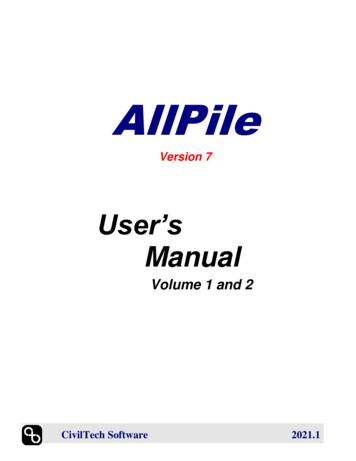


![Pile Foundation Design[1] - ITD](/img/29/pilefoundationdesign.jpg)
